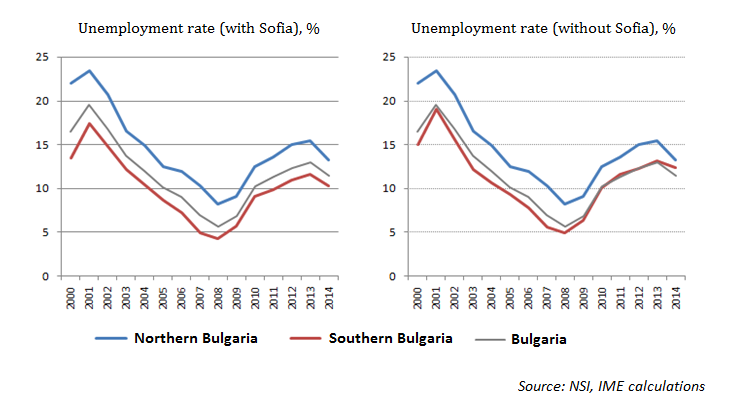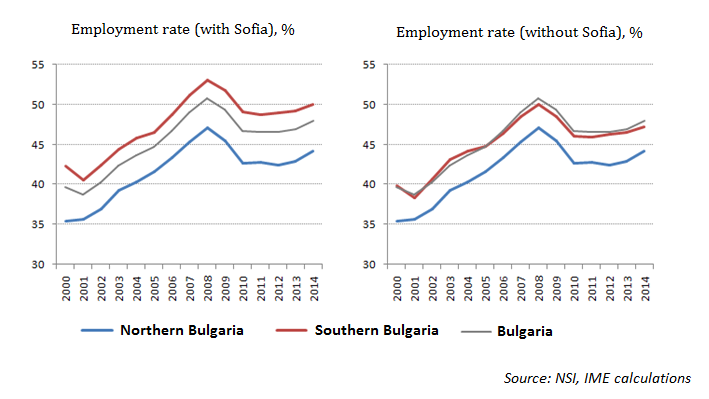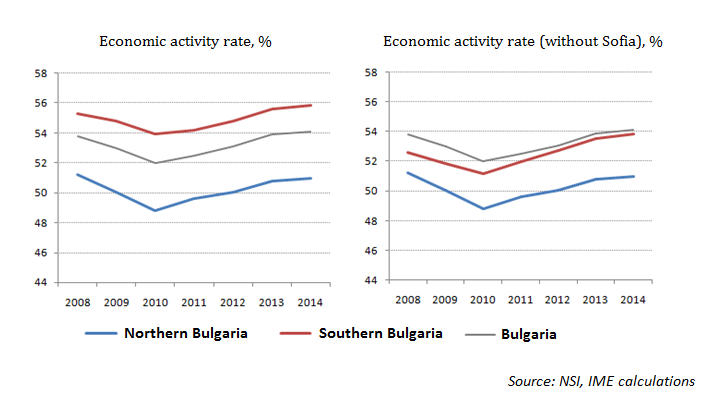Differences between Labour Markets in Northern and Southern Bulgaria
Martina Goranova*, Desislava Nikolova
Athough there are some inevitable economic divergences between Bulgaria’s districts, it would be interesting to check the assumption about the economic discrepancy between the labour markets of North and South Bulgaria. In order to reply to this question, we will compare three indicators that define the labour market - the unemployment rate, the employment rate, and the economic activity rate.
Regarding the unemployment rate, the difference between the weighted averages for Northern and Southern Bulgaria has narrowed to 2.85 percentage points in 2014 down from 8.58 pp back in 2000. That means the unemployment rate was generally higher in North Bulgaria both during the upturn untill 2008 and during the crisis period and the post-crisis recovery following 2009. It is interesting that the gap has considerably narrowed during the the past 15 years (about 3 times), which in principle could be interpreted as a decrease in the discrepancy between Northern and Southern Bulgaria in recent years, at least in terms of the unemployment rate.
If the capital city was disregarded, the better state of South Bulgaria would have been preserved, namely the average unemployment rate in South Bulgaria would have been 0.93 pp lower than the one in Northern Bulgaria in 2014. So, it turns out that Southern Bulgaria’s better indicators are not only due to the capital city—even without it, this part of Bulgaria would have performed better in terms of its labour market. Nonetheless, the capital city accounted for 2/3 of the difference between the unemployment rates in North and South Bulgaria as of 2014, i.e. its influence should not be underestimated.
The employment rate generally increased in Bulgaria from 2000 to 2008 and it grew again following a drop in 2009-2010.
In respect of the employment rate, the capital city’s influence has also been considerable. The discrepancy in the employment rate between Northern and Southern Bulgaria, excluding Sofia, would be almost double. The divergence between both parts was 5.81 pp in 2014, and if the capital city was disregarded, it would have been 2.95 pp. And still, as it is visible from the figures, the employment rate has been higher in South Bulgaria, notwithstanding the capital city’s influence. In 2014, this rate was 44.23% in North Bulgaria, and 50.05% in South Bulgaria.
It is notable that the difference between Northern and Southern Bulgaria in terms of employment rates has remained stable in time, fluctuating from 5 to 7 pp. Thus, if the data about the unemployment rate supported the assumption that North and South Bulgaria had developed more closely in recent years, then the data regarding actual employment would have firmly rejected it.
The labour market has gradually recovered in recent years, but the employment rate and the unemployment rate have not reached their pre-crisis levels. The differences between both parts of Bulgaria, in respect to employment, have not significantly changed in time, which constitutes another indicator of the insufficient effectiveness of the regional policy and the ongoing discrepancy between Northern and Southern Bulgaria. The interesting point is that Sofia (the capital city) is not the only “culprit” for South Bulgaria’s better rank — South Bulgaria has performed well even without Sofia, in respect of all basic labour market indicators. It should even be noted that role of Sofia (the capital city) concerning South Bulgaria’s advantage has gradually decreased. For instance, if the difference in the unemployment rates between North and South Bulgaria, excluding Sofia, was about 7 pp in 2000, it dropped to barely 1 pp in 2014. The same applies to the employment rate, even though the role of Sofia has slightly weakened—the difference between North and South Bulgaria, excluding Sofia, was 4.4 pp in 2000, and it decreased to about 3 pp in 2014.
* The author is an intern at the IME.




